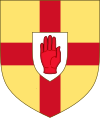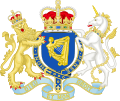Herb Irlandii
 | |
| Informacje | |
| Wprowadzono | 9 września 1945 |
|---|---|
Herbem Irlandii jest złota harfa o srebrnych strunach w błękitnym polu. To godło sięgające średniowiecza nazywane jest harfą Briana Śmiałego (pierwowzór herbu Irlandii znajduje się Trinity College w Dublinie). Widniała ona również na flagach oddziałów irlandzkich tworzonych w armiach na kontynencie europejskim w XVII-XVIII wieku.
Herb w obecnej wersji obowiązuje od 9 września 1945. Poprzedni herb przedstawiał na tarczy czwórdzielnej w krzyż, herby czterech irlandzkich prowincji: Leinster, Connacht, Ulster i Munster.
Harfa pojawiła się w 1207 na monetach angielskich bitych dla Irlandii. Harfy jako symbolu Irlandii po raz pierwszy użył król Anglii Henryk VIII w 1541 w wielopolowym herbie Królestwa Anglii. Od 1801 harfa (w stylizacji angielskiej) widnieje w herbie Zjednoczonego Królestwa Wielkiej Brytanii i Irlandii Północnej.
Harfa jest popularnym instrumentem irlandzkim, jej wizerunek znajduje się na rewersach irlandzkich euro.
Symbolem narodowym jest też trójlistna koniczyna - shamrock, która jest oficjalnym godłem (ang. heraldic badge), mogącym zastępować herb przy mniej oficjalnych okazjach.
Herby prowincji
Historyczne warianty Herbu
Irlandia feudalna 1171–1542
Królestwo Irlandii 1542–1800
Wolne Państwo Irlandzkie 1922-1937
Zobacz też
Media użyte na tej stronie
Arms of Ireland. Blazon: Azure, a harp or stringed argent.
Autor: Sodacan, Licencja: CC BY-SA 3.0
Coat of Arms of the United Kingdom from 1837 to 1952 used by Queen Victoria, King Edward VII, George V, Edward VIII and George VI.
| “ | Quarterly, First and Fourth Gules three lions passant guardant in pale Or armed and langued Azure (for England), Second quarter Or a lion rampant within a double tressure flory counter-flory Gules (for Scotland), Third quarter Azure a harp Or stringed Argent (for Ireland), the whole surrounded by the Garter; for a Crest, upon the Royal helm the imperial crown Proper, thereon a lion statant guardant Or imperially crowned Proper; Mantling Or and ermine; for Supporters, dexter a lion rampant guardant Or crowned as the Crest, sinister a unicorn Argent armed, crined and unguled Proper, gorged with a coronet Or composed of crosses patée and fleurs de lys a chain affixed thereto passing between the forelegs and reflexed over the back also Or; Motto 'Dieu et mon Droit' in the compartment below the shield, with the Union rose, shamrock and thistle engrafted on the same stem. | ” |
- PINCHES, J.H & R.V., The Royal Heraldry of England, 1974, Heraldry Today.
Autor: Caomhan27, Licencja: CC BY-SA 3.0
Fictional coat of arms of Ireland featuring the arms of the four provinces of Ireland
Autor: NsMn, Licencja: CC BY 3.0
The coat of arms of the former lordship of Ireland, SVG version.
Autor: Ten obraz wektorowy zawiera elementy, które zostały zaczerpnięte lub zaadaptowane z tego pliku:, Licencja: CC BY-SA 3.0
Coat of arms of the Kingdom of Ireland, 1542 – 1800 (as shown on the Custom House Dublin, 1791 – see File:The_Custom_House_Dublin_Crest_Irish_Harp.jpg). Note that this particular version would likely have been used only after 1707.






















